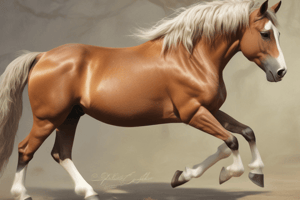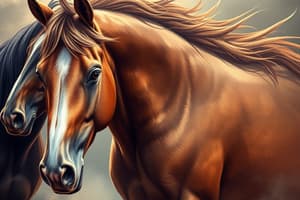Podcast
Questions and Answers
What is the maximum height allowed for a Miniature Horse according to the registry?
What is the maximum height allowed for a Miniature Horse according to the registry?
- 36 inches
- 32 inches
- 34 inches (correct)
- 38 inches
Which type of pony is known for being good harness horses?
Which type of pony is known for being good harness horses?
- Hackney Pony (correct)
- Shetland Pony
- Pony of The Americas
- Welsh pony
Which of the following is NOT a use for Miniature Horses?
Which of the following is NOT a use for Miniature Horses?
- Driving classes
- Kept as pets
- Riding by small children
- Draft animal work (correct)
Gaited breeds are particularly suited for what activity?
Gaited breeds are particularly suited for what activity?
What is the primary characteristic of ponies in terms of size?
What is the primary characteristic of ponies in terms of size?
What is the common measurement used for horse height?
What is the common measurement used for horse height?
Which of the following terms is used to describe horses that are sturdy and placid but not classified as draft animals?
Which of the following terms is used to describe horses that are sturdy and placid but not classified as draft animals?
What classification would a horse primarily used for racing fall under?
What classification would a horse primarily used for racing fall under?
How are mules produced?
How are mules produced?
Which of the following is NOT a recognized type of horse classification?
Which of the following is NOT a recognized type of horse classification?
What is the primary function of recognizing different horse breeds?
What is the primary function of recognizing different horse breeds?
Which term refers specifically to the classification of horses based on their overall characteristics, such as function and conformation?
Which term refers specifically to the classification of horses based on their overall characteristics, such as function and conformation?
What common characteristic do recognized horse breeds share?
What common characteristic do recognized horse breeds share?
What classification is given to breeds that are at high risk of extinction?
What classification is given to breeds that are at high risk of extinction?
Which of the following is not a category of mules based on historical classifications?
Which of the following is not a category of mules based on historical classifications?
What is the requirement for a donkey to be registered in the Miniature Donkey Registry of the United States?
What is the requirement for a donkey to be registered in the Miniature Donkey Registry of the United States?
Which of the following accurately describes a hinny?
Which of the following accurately describes a hinny?
Which of the following laws is aimed at protecting wild horses?
Which of the following laws is aimed at protecting wild horses?
Which breed is not categorized as a registered donkey breed?
Which breed is not categorized as a registered donkey breed?
What term is used for the combination of a zebra and an equine?
What term is used for the combination of a zebra and an equine?
How many breeds of horses approximately exist worldwide?
How many breeds of horses approximately exist worldwide?
Flashcards
Breed
Breed
Horses originating from the same lineage with consistent traits like function, conformation, and color.
Stud book
Stud book
A formal record of breeding and lineage for a specific horse breed.
Foundation Stallion
Foundation Stallion
The original male horse that established a breed's genetic foundation.
Registries
Registries
Signup and view all the flashcards
Horse Height - Hand
Horse Height - Hand
Signup and view all the flashcards
Draft Horses
Draft Horses
Signup and view all the flashcards
Cobs
Cobs
Signup and view all the flashcards
Hacks
Hacks
Signup and view all the flashcards
Gaited Breeds
Gaited Breeds
Signup and view all the flashcards
Miniature Horse Breeding
Miniature Horse Breeding
Signup and view all the flashcards
Miniature Horse Height Limit
Miniature Horse Height Limit
Signup and view all the flashcards
Ponies
Ponies
Signup and view all the flashcards
Welsh Pony and Cob
Welsh Pony and Cob
Signup and view all the flashcards
Rare Breed Classification
Rare Breed Classification
Signup and view all the flashcards
Feral Horses
Feral Horses
Signup and view all the flashcards
Wild Horse Protection Laws
Wild Horse Protection Laws
Signup and view all the flashcards
Mule
Mule
Signup and view all the flashcards
Miniature Donkey
Miniature Donkey
Signup and view all the flashcards
Zebroid
Zebroid
Signup and view all the flashcards
Historical Mule Classifications
Historical Mule Classifications
Signup and view all the flashcards
Study Notes
Learning Objectives
- Students will be able to discuss how horse breeds originated from foundation stallions.
- Students will be able to understand breed classifications and types.
- Students will be able to describe common horse height measurement.
- Students will be able to define the terms warmblood, coldblood, cob, and hack.
- Students will be able to name ten common light horse breeds and their origins.
- Students will be able to name five common draft horse breeds and their origins.
- Students will be able to name five breeds of ponies and their origins.
- Students will be able to list five common horse colors.
- Students will be able to identify five lesser-known horse/pony breeds and their origins.
- Students will be able to explain the origin of feral horses.
- Students will be able to describe the process of mule production.
- Students will be able to list ten uses for horses.
- Students will be able to describe the uses of miniature donkeys and horses.
- Students will be able to list six uses for mules.
Introduction
- Humans created horses through selection, inbreeding, and outcrossing for characteristics such as speed, strength, endurance, size, good nature, hardiness, beauty, and athletic ability.
- This chapter will cover horse breeds and the methods/terms used to classify them.
Breeds
-
Overview
- Horses with a common ancestry are considered a breed.
- Breeds are true to produce common characteristics.
- Characteristics often include function, conformation, and color.
-
Overview
- Recognized breeds have stud books and breeding records.
- Foundation sires are used to maintain these records.
- Records are managed through registries.
- Color requirements and conformation standards are adhered to.
Classification and Types
- Overview
- Horse types are determined by height and weight.
- Height is measured from the top of the withers to the ground in "hands."
- One hand equals four inches.
- Horse Classifications
- Light, draft, or pony
- Riding, racing, driving, jumping, or utility
- Warmblood, coldblood, or pony
Classification and Types continued
- Overview
- Cob - sturdy, placid, horses, not heavy or course enough for draft animals
- Hack - enjoyable riding or driving animals
Classification and Types continued
- Overview
- Uses
- Riding
- Racing
- Driving
- All-purpose
- Miniature
- Uses
Common Breeds of Horses
- Overview
- Includes a table of names, origins, classifications, heights, and colors of well known horse breeds.
Ponies
- Overview
- Types of Ponies by use
- Welsh Pony and Cob (14.2 hands or less), sturdy, placid, not heavy or coarse enough for draft animals, good for riding or driving
- Pony of The Americas (POA) (46-54 inches)
- Miniature Horse (34 inches or under)
- Shetland Pony (34-38 inches)
- Hackney Pony, good harness horses
- Types of Ponies by use
Miniature Horses
- Overview
- Scaled-down versions of full-size horses; not dwarfs, nor a breed.
- Miniature Horse Registry
- Maximum height is 34 inches at the withers.
- Uses
- Kept as pets
- Exhibited as driving horses
- Single pleasure and roadster classes
- Multiple hitches
- Ridden by small children
Gaited Breeds
- Overview
- Additional gaits beyond the usual walk, trot, canter, and gallop
- Ideal for extended riding periods
- Can maintain gait without expending significant energy
- Examples
- Standardbred
- Saddlebred
- Tennessee Walker
- Missouri Fox Trotter
- Paso Fino
- Peruvian Paso
- Icelandic
Rare Breeds
- Overview
- Some breeds threatened
- Agriculture changes have impacted traditional livestock breeds
- Lost breed popularity, making them important resources for future biodiversity
- Classifications
- Critical
- Threatened
- Watch
- Recovering
Wild Horses
- Overview
- Feral horses, once domesticated, have become wild; also called mustangs.
- Habitats are typically public lands.
- Protection
- Two federal laws (Public Laws 86-234 and 92-195)
- Excessive animals made available to the public through the National Adopt-A-Horse and Burro Program.
Donkeys
- Overview
- Registered Breeds
- American Donkey and Mule Society
- Mammoth jack
- Large standard donkey
- Standard donkey
- American Spotted Ass
- Miniature Mediterranean donkey
- Registered Breeds
- Miniature Donkey
- Miniature Donkey Registry of the United States
- Governed by the American Donkey and Mule Society
- Founded in 1958, with a height requirement of 36 inches or less.
Mules
- Overview
- Cross between a donkey and a horse
- Named according to parentage (Mule/Hinny)
- Classifications
- Historical classifications: Draft and sugar mules, Farm and cotton mules, Pack and mining mules
- Today's classifications: Draft, pack/work, saddle, driving, jumping, or miniature
- Zebra Hybrids
- Zebroid, Zebrass, Ze-donk, Zony, Zeony
Summary
- Worldwide, roughly 300 horse breeds exist.
- Breeds with common ancestry are registered in breed registry associations.
- Mule type depends on the breed and type of donkey/horse used for the cross.
Studying That Suits You
Use AI to generate personalized quizzes and flashcards to suit your learning preferences.



